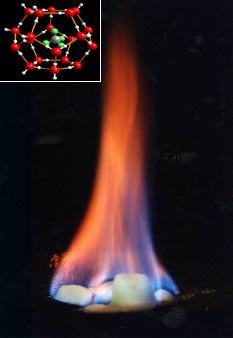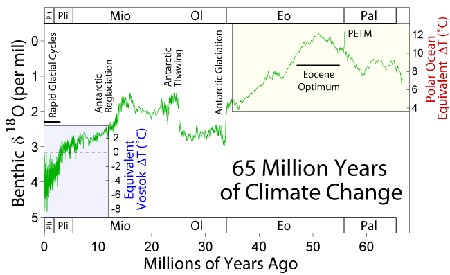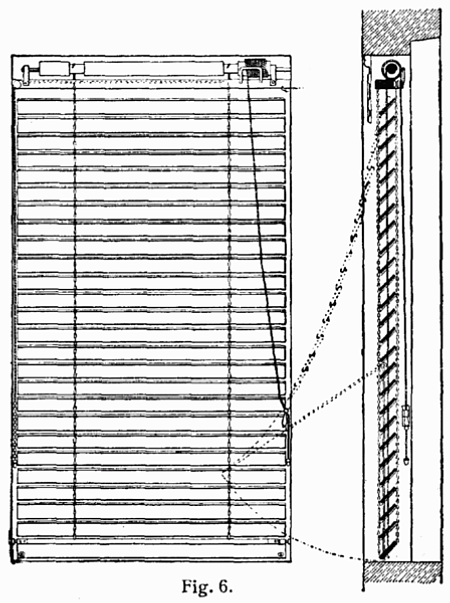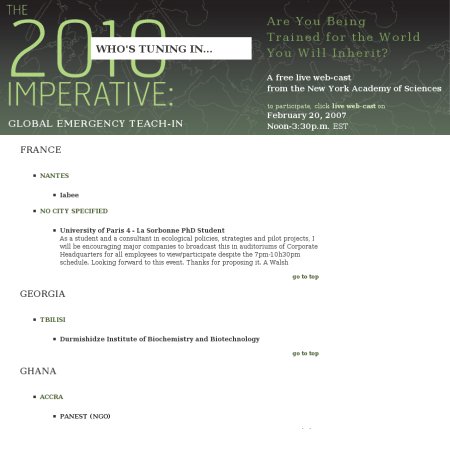
image from
wikipedia
A Methane clathrate, also called methane hydrate or methane ice, is a form of water ice that encloses a large amount of trapped methane gas within its crystal structure.
In contrast to usual water ice the methane ice can burn (see image).
Large deposits of methane ice have been found hidden under sediments of Earth. Moreover below the zone of solid methane ice, large volumes of methane may occur as bubbles of free gas in the sediments.
The discharge of methane (coming from the ice) is under suspect to have furthered the Paleocene-Eocene Thermal Maximum (PETM) a sudden global climate change, which upset oceanic and atmospheric circulation and led to the largest known mass extinction.

image from wikipedia.
This suspect or hypothesis is called the Clathrate gun hypothesis and was e.g. summarized in the BBC2 ‘Horizon’ documentary, ‘The Day the Earth Nearly Died. The basic idea is that a global warming due to e.g. a giant volcano outbreak let to the discharge of big methane gas clouds which were stored in the methan ice (i.e. massive gas clouds were suddenly released due to the warming). These methane clouds in the turn enforced the greenhouse effect und thus produced even more global warming (a runaway greenhouse effect). This happened too fast for organisms to adapt and thus leading to a mass extinction of 95% of the species on the earth (for more read the BBC link).
Well this is a hypothesis and the current computed climate change is not yet in the dangerous temperature region, but we are getting closer rather fast if we go on like that.
Hopefully the current global warming won’t end up in such a terrifying scenario. However it is clear that the discharge of further greenhouse gases and Deforestation* must be dramatically reduced. In particular it should again be emphasized that it is mainly the speed which kills and it kills already now (see e.g. here).
But unfortunately there are not only plans to burn the resources hidden under the melting polar ice but also to exploit the methane in the clathrates, like e.g. these japanese or US project. Burning methane produces again, like other fossil fuels, the greenhouse gas carbon dioxide.
Which means: there may be plenty to burn. One shouldn’t. **
comment added 11.1.2019:
*Regarding deforestation:
With respect to the earth temperature there are meanwhile indications that deforestation might have a more or less significant
cooling effect due to the related change in brightness (forests look darker than grasslands and thus absorb more heat). This is as of now under investigation
Jamie Wilson from unitedbankofcarbon writes here.
By gaining a clearer picture of the changes in some of the lesser known interactions, the overall climatic impact of deforestation can be better understood, enabling both more informed policy decisions around land-use to tackle climate change and better understanding as to how such decisions will impact the climate.
**Regarding the burning of clathrates:
In opposition to what I wrote above I meanwhile do think that it might eventually be necessary to get the methane out of the clathrates, which might include
burning. That is it seems the impact of methane as a climate change driver might have been underestimated and thus gas discharges from clathrates and permafrost
might be so destructive that it would be better to burn them (which produces less potent CO2). But of course in terms of CO2 reduction it would be better not to just burn, how it has mostly been done until now, but to burn the methane in
a controlled way which retains the CO2 like in a socalled CCS power plant, so that the CO2 could be used somewhere else.
comment march 5, 2019: A research group of TU Vienna has shown that it is possible to burn methane while keeping the CO2 onsite, as reported in Natural gas facilities with no CO2 emissions.
comment August 8, 2019: There seem to be new developments for improved techniques to produce hydrogen from methane via socalled “methane decarbonisation” also called “methane cracking”. Like in a research project by Karlsruhe Institute of Technology (KIT) and the Institute for Advanced Sustainability Studies (IASS) in Potsdam continuous pyrolytic cleavage of methane was achieved by using
molten tin as a heat transfer and liquid medium in a bubble column reactor. In the process methane gas is continuously introduced from below into a liquid metal column maintained at up to 1,200 degrees Celsius, where it rises to the surface as a swarm of bubbles. The gas in the bubbles reaches the reaction temperature very quickly, resulting in a pyrolysis reaction.
Current fracking techniques however seem to bring high leakages/emissions with them as pointed out in a study about the prospects of european shale gas:
The emission intensity of shale gas in electricity generation is up to 35 per cent higher than estimates of the current emission intensity of conventional gas in Germany. The study also questions the accuracy of methane leakage estimates for current conventional gas production.
and
“The major differences between the realistic and optimistic scenarios in terms of their anticipated emissions underline once again the importance of improving existing emissions reduction technologies and practices,” says Cremonese.
In this context you may be interested in reading this randform comment.
comment November 21, 2020:
Some links as a reference to new trends in hydrate research:
– a brief note in relation to Japans research in particular in continuation to MH21 by company Japex:
In March 2013, the offshore production test of sand-layer type methane hydrate was executed at the Daini Atsumi Knoll where is located off the coast between Atsumi Peninsula and Shima Peninsula and it achieved continuous production of methane gas from a methane hydrate-bearing layer for the first time in the world, in 6 consecutive days with an average of 20,000 cubic meters per day and cumulative of approximately 120,000 cubic meters (*3). In April to July 2017, the second offshore production test of methane hydrate in an effort to produce gas was executed and produced total 260,000 cubic meters of methane gas from 2 wells in 36 days (*4). Based on these results, the government will continue to proceed with technology research and development concerning methane hydrate while looking at the international situation, with consideration to launching its commercialization project led by private sector after 2023.
–russian wikipedia writes that Gasprom conducts experiments, however doesn’t cite anything:
В настоящее время во ВНИИГАЗе начат новый цикл исследований по предупреждению техногенного гидратообразования. Значительные усилия учёных А. И. Гриценко, В. И. Мурина, Е. Н. Ивакина и В. М. Булейко были посвящены исследованиям теплофизических свойств газовых гидратов (теплотам фазовых переходов, теплоемкостям и теплопроводностям).
-a report of experiments with a kind of hydrate fracking/carbon sequestration method in:
An Experimental Investigation on the Kinetics of Integrated Methane Recovery and CO2 Sequestration by Injection of Flue Gas into Permafrost Methane Hydrate Reservoirs
– a collection of US hydrate research activities by NETL – “a U.S. Department of Energy national laboratory that produces technological solutions for America’s energy challenges. ”
– a recap of Germany’s SUGAR project
– the 2017 study in Nature Communication: Gas Hydrate Dissociation off Svalbard Induced by Isostatic Rebound rather than Global Warming
In this context you may also want to read the 2015 randform post about: methane and tectonics and the 2017 post: what’s going on at the Ural?
comment January 20, 2022:
Regarding the above mentioned pyrolysis of methane, one could remark that this method may in principle substitute Steam reforming.
comment June 5. 2022:
Unfortunately a local project which applied for research funding in order to investigate the commercial use of hydrogen (as for example obtained in methane pyrolysis) by enhancing the use of gas turbines) was, as I understood just scrapped, that is Berliner Woche writes:
Aus dem Bericht der Haushaltsberatungen im Wirtschaftsausschuss des Abgeordnetenhauses geht hervor, dass der Bund das Projekt zur Wasserstoff-Förderung nicht ausgewählt hat. Der Grund ist dem Bericht nicht zu entnehmen. Ohne die Unterstützung des Bundes sei eine Umsetzung finanziell nicht möglich. Das Projekt ,,H2@Marzahn – H2-Baustein Dekarbonisierung Fernwärme“ könne deshalb nicht realisiert werden.
So the project was apparently not approved by “the Bund” (the federal government). Details of decisions are however discussed in the Wirtschaftsausschuss
Berliner Woche describes the project as:
Bei dem Projekt wollten die Vattenfall Wärme Berlin AG, Siemens Energy und die TU Berlin im Heizkraftwerk Marzahn bei laufenden Betrieb an den kraftwerkstechnischen Gegebenheiten forschen und diese weiterentwickeln. Geplant war, eine zur Kraft-Wärmeerzeugung eingesetzte Siemens-Gasturbine nach und nach mit höheren Wasserstoffkonzentrationen im Brenngas betreiben zu können. Vor Ort erzeugter und zwischengelagerter grüner Wasserstoff sollte dabei Verwendung finden und durch eine H2-Tankstelle auch dem Kfz-Verkehr zur Verfügung gestellt werden.
I was interested in how many of the members of the Wirtschaftsaussschuss have a “technical background” and thus are eventually more prone to wage different technical processes against each other. I count 6 out of 34 (indicated with a #). Thats 6/34 = 18% The following list of members is according to Wikipedia not fully up-to-date and the professional backgrounds (also from Wikipedia) are very rough and partially probably erranous, so the list should be taken with a grain of salt, but here the backgrounds:
# Walter – car mechanics, business
Arlt – army, event management
# Kazmarek – chemical laboratory
Limbacher – law
Mohrs – business
Poschmann – business, law
Roloff – law
Töns – politics
Werner – business, tourism
# Westphal – chemical laboratory
Grosse-Böhmer – law
Durz – business
Klöckner – politics, theology
Kuban – law
Loos – politics, business
Merz – law
Metzler – business
Rouenhoff – construction, politics, business
Willsch – politics, business
# Außendorf – math, IT
Banaszak – cult. Anthropology, politics
Detzer – politics, business
Janecek – politics
Sekmen – business
# Bauer – electrotechnics, business
Houben – business
# Todtenhausen – electrotechnics
Ullrich – business
Holm – economics, radio host
Kaufmann – business
Komning – army, law
Schulz – business
Leye – economics
Meiser – politics, psychology
correction 24.11.2022 to comment June 5. 2022:
The sentence
Aus dem Bericht der Haushaltsberatungen im Wirtschaftsausschuss des Abgeordnetenhauses geht hervor, dass der Bund das Projekt zur Wasserstoff-Förderung nicht ausgewählt hat.
in the citation of “Berliner Woche” is a bit ambiguous in that, that there exists also a “Wirtschaftausschuss” and an “Abgeordnetenhaus” in Berlin. In fact the “Abgeordnetenhaus” of the federal government is usually called “Bundestag” and if people in Berlin speak about the “Abgeordnetenhaus” they usually mean the local parliament of Berlin and not the Bundestag. I should have thought about that. In short: in the above comment I noticed now that I had probably wrongly interpreted the Berlin “Abgeordnetenhaus” as being the “Bundestag”, because I couldn’t find anything on the topic in the protokolls of the Wirtsschaftsausschuss of the Bundestag. It doesn’t seem to be a typical topic. So it seems the topic was apparently just discussed in the Wirtschaftsausschuss of the Berlin Abgeordnetenhaus as I also couldn’t find anything in the protokolls (starting from January) there and that the descision about the H2 project was made somewhere else. I couldn’t find out much more about where the decision was made.
24.11.2022 :
The Nature article: “How the hydrogen revolution can help save the planet — and how it can’t” (via Sabine Hossenfelder) describes among others how hydrogen can be used in the steel industry:
The hydrogen-to-steel route isn’t entirely pollution-free; other steps in converting iron to steel still emit some CO2, and the iron ore must be mined. Still, last year, this site produced the world’s first ‘green steel’, with the aid of hydrogen that was made using Sweden’s abundant low-carbon electricity, generated from hydropower, nuclear and wind.
I wouldn’t call steel production which uses nuclear power “green”, since nuclear power production is everything else than “green” – so this is greenwashing, but the article gives apart from the description of certain steel production methods some overview over other possibilities of hydrogen and:
Partly as a result, investment in hydrogen projects is experiencing a boom.
So there is a lot of competition and maybe public funding for the above project was deemed not necessary for that reason? Regarding the hydrogen for turbines it is said in the article:
In particularly dire times of the year, it could be used to generate electricity again by burning it in turbines similar to those that run on natural gas, although this would be very wasteful: the grid would get back only one-third or less of the electricity originally put into making the hydrogen.
It’s not clear whether this is the most cost-effective way to decarbonize the last 20% of electricity, compared with building nuclear-power stations or perhaps expanding geothermal energy. The optimal mix will probably vary between countries, suggest region-specific studies by organizations such as the United Nations International Renewable Energy Agency.
At this place I would like to point out that transporting electric energy is also “wasteful” to some extend -> Übertragungsverlust.
![]()



 (image from
(image from 

